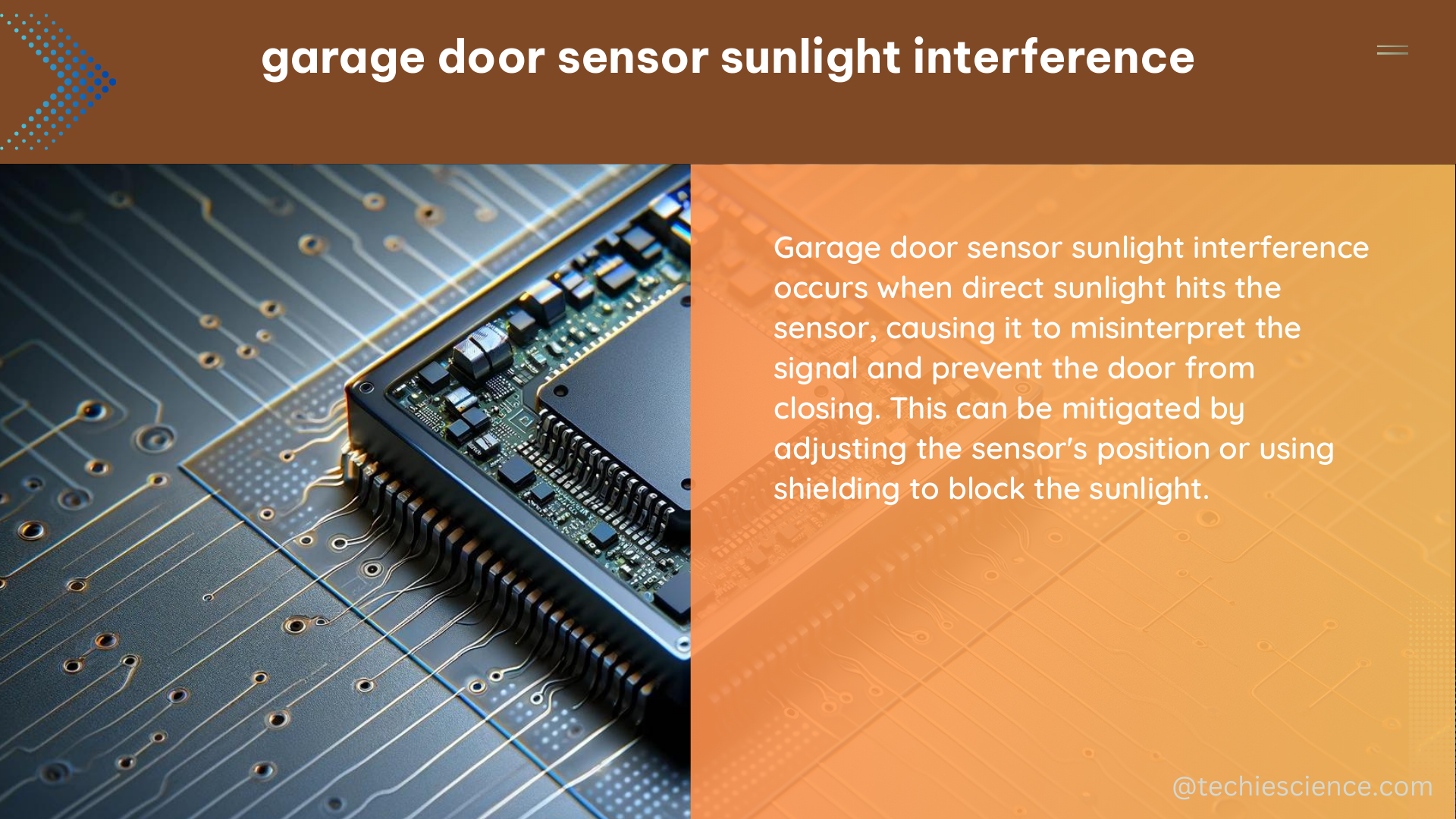Garage door sensor sunlight interference is a common issue that can significantly impact the proper functioning of your garage door system. This interference is caused by the reflection or refraction of sunlight on the sensor, which can result in false signals and prevent the door from opening or closing correctly. While there is limited specific data or research on the measurement of this interference, understanding the technical specifications and best practices can help you effectively mitigate its impact.
Understanding Garage Door Sensor Technology
Garage door sensors typically utilize infrared technology to detect obstacles and prevent the door from closing. These sensors are usually located on either side of the door and emit a beam of infrared light that is reflected back to the sensor when an object is detected. However, direct sunlight can interfere with this signal, causing false positives or negatives.
The intensity of sunlight can vary depending on factors such as the time of day, weather conditions, and the sensor’s positioning. According to the International Test and Evaluation Association (ITEA) Journal, the development of advanced multi-spectral simulation test acceptance resources (AMSTAR) HWIL facilities involves tradeoffs in the modeling of wireless network simulations, including the impact of sunlight on sensor streams. This suggests that the interference caused by sunlight on garage door sensors is a recognized issue that can affect the performance of wireless systems.
Measuring Sunlight Interference

While there is no specific data or research on the direct measurement of garage door sensor sunlight interference, there are some indirect measurements and technical specifications that can provide insights:
-
Infrared Sensor Sensitivity: Garage door sensors typically operate in the infrared spectrum, with wavelengths ranging from 850 to 950 nanometers (nm). The sensitivity of these sensors can be affected by the intensity of sunlight, which also emits infrared radiation.
-
Ambient Light Levels: The U.S. Department of Energy’s Energy Conservation Standards for General Service Lamps (GSL) mention the use of halogen lamps that emit light that mimics natural sunlight, which can be used with garage door openers without causing interference. This suggests that the choice of lighting can have a significant impact on the proper functioning of garage door sensors.
-
Sensor Angle and Positioning: The angle and positioning of the garage door sensors can greatly influence their susceptibility to sunlight interference. Sensors that are directly exposed to sunlight are more likely to experience interference compared to those that are positioned in shaded areas.
-
Sensor Anti-Glare Technology: Some garage door sensors are designed with “anti-glare” or “sunlight filtering” features that help reduce the impact of direct sunlight on the sensor’s performance. These technologies can help mitigate the effects of sunlight interference.
Minimizing Sunlight Interference
To effectively minimize the impact of garage door sensor sunlight interference, homeowners can implement the following DIY solutions:
1. Adjusting Sensor Angle
The sensors should be angled so that they are not directly exposed to sunlight. This can be done by adjusting the bracket that holds the sensor. Ideally, the sensor should be positioned at a 15-30 degree angle from the horizontal plane to reduce the impact of direct sunlight.
2. Shading the Sensor
A simple shading device, such as a piece of cardboard or plastic, can be used to block direct sunlight from hitting the sensor. This can be an effective solution, especially in cases where the sensor cannot be repositioned or angled properly.
3. Relocating the Sensor
If adjusting the angle or shading the sensor does not work, the sensor can be relocated to a shadier spot. This may involve moving the sensor to a different location on the garage door frame or finding a more suitable mounting position.
4. Using Sensors with Anti-Glare Technology
Some garage door sensors are designed with advanced anti-glare or sunlight filtering features that help reduce the impact of direct sunlight on the sensor’s performance. These sensors may be more expensive, but they can provide a more reliable solution for homeowners dealing with sunlight interference.
5. Monitoring Sensor Performance
Regularly monitoring the performance of your garage door sensors can help you identify and address any issues related to sunlight interference. This may involve testing the sensors under different lighting conditions and making adjustments as needed.
Conclusion
Garage door sensor sunlight interference is a common issue that can significantly impact the proper functioning of your garage door system. By understanding the technical specifications and best practices, homeowners can effectively mitigate the effects of this interference and ensure the reliable operation of their garage door sensors. By implementing the DIY solutions outlined in this guide, you can enjoy a smooth and safe garage door experience, even in the presence of direct sunlight.
References
- Hamida, B., G. Chelius, and J. Gorce. 2008. Scalable versus accurate physical layer modeling in wireless network simulations. In 22nd Workshop on Principles of Advanced and Distributed Simulation. Rome, Italy: IEEE Computer Society (ACM Portal), pp. 127–134.
- U.S. Department of Energy. 2024-04-09. Energy Conservation Standards for General Service Lamps.
- Chamberlain Group. 2021. Garage Door Sensor Troubleshooting.
- LiftMaster. 2021. Garage Door Sensor Troubleshooting.
- Genie Company. 2021. Garage Door Sensor Troubleshooting.

The lambdageeks.com Core SME Team is a group of experienced subject matter experts from diverse scientific and technical fields including Physics, Chemistry, Technology,Electronics & Electrical Engineering, Automotive, Mechanical Engineering. Our team collaborates to create high-quality, well-researched articles on a wide range of science and technology topics for the lambdageeks.com website.
All Our Senior SME are having more than 7 Years of experience in the respective fields . They are either Working Industry Professionals or assocaited With different Universities. Refer Our Authors Page to get to know About our Core SMEs.